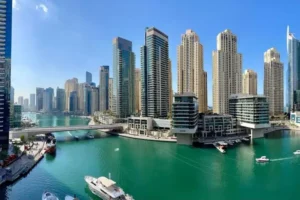
In the intricate tapestry of economic landscapes, Dubai stands as a dynamic player, its economic pulse reflected in the fluctuations of the Consumer Price Index (CPI). This article delves into the nuances of Dubai’s CPI movements, exploring the recent moderate uptick in December 2023 and dissecting the driving factors behind this shift. As we embark on this exploration, we will also navigate through the broader canvas of global inflation trends, the unique trajectory of the Gulf Cooperation Council (GCC) nations, and the geopolitical challenges that add layers of complexity to economic considerations.
Dubai’s December 2023 CPI: A Microscopic View
Decoding the Numbers
Dubai’s Consumer Price Index experienced a moderate uptick of 3.3 percent in December 2023, a marginal decrease from the 3.4 percent increase witnessed in December 2022, according to a recent report. This micro-level examination sets the stage for a deeper understanding of the city’s economic dynamics and the factors influencing its inflationary trends.
GCC Inflation Landscape: Dubai’s Distinct Stance
Kamco Invest’s Insightful Analysis
Against the backdrop of GCC nations, Dubai emerges as a distinct outlier in its average annual inflation rate. Kamco Invest’s GCC Inflation Update for February paints a contrasting picture as Dubai reported an increase in its average annual inflation rate from 2.9 percent in 2022 to 3.3 percent in 2023. This divergence from the general trend, where other GCC nations witnessed a decline in their average annual inflation rates, prompts an exploration into the unique economic dynamics shaping Dubai’s inflationary landscape.
Exploring Driving Forces: Dubai’s CPI Growth
Detailed Analysis of Subgroups
The intricate web of CPI growth in Dubai is woven by various subgroups, each playing a distinctive role in shaping the overall economic narrative. The housing, water, electricity, and gas group, holding the highest weight, experienced a noteworthy 6.1 percent increase in December 2023. Simultaneously, the food and beverages group, the third-highest weighted, recorded a significant 4.2 percent increase – a stark contrast to the decline observed in December 2022. Conversely, the transport subgroup, the second-largest weighted group, saw a 5.8 percent decline in December. This detailed dissection provides insights into the intricate interplay of factors influencing CPI growth in Dubai.
Global Context: GCC Amidst Global Inflationary Trends
Comparative Analysis with OECD Projections
Zooming out from the microcosm of Dubai, we turn our attention to the broader canvas of global inflation trends. The Organisation for Economic Co-operation and Development (OECD) projections paint a comparative picture, with global headline inflation estimated to decrease to 7 percent in 2023 and further to 5.2 percent in 2024, down from an average of 9.5 percent in 2022. This global perspective serves as a crucial backdrop for understanding how Dubai’s inflation trends fit into the larger narrative of the world’s economic trajectory.
Central Banks’ Response and Global Geopolitical Challenges
Impact of Global Borrowing Rates
As we traverse the global economic landscape, the response of central banks becomes a pivotal aspect. The International Monetary Fund (IMF) reports a significant increase in global borrowing rates, with advanced economies witnessing approximately 400 basis points (bps) and emerging market economies experiencing around 650 bps from late 2021 to October 2023. This rise in global borrowing rates casts a shadow on the global economy, prompting central banks to take unified actions in raising benchmark rates.
Navigating New Geopolitical Challenges: The Red Sea Crisis
Potential Impacts on GCC Inflation
Amidst the global economic intricacies, new geopolitical challenges emerge as potential disruptors. The ongoing war in Gaza and disruptions in global shipping lines in the Red Sea introduce a layer of uncertainty. The BMI highlights that Middle East consumers are particularly exposed to the Red Sea crisis, with a significant percentage of the region’s imports relying on Red Sea routes. The potential for heightened costs of goods and its subsequent impact on inflation in both the GCC and the wider Middle East and North Africa (MENA) region becomes a critical consideration.
Conclusion: Economic Stewardship in Uncertain Waters
Charting the Course Forward
In the labyrinth of economic dynamics, Dubai’s CPI trends offer a microcosmic insight into the city’s economic health. The intricate dance of various factors, from housing and food to global borrowing rates and geopolitical challenges, shapes the narrative of Dubai’s economic trajectory. As the city grapples with a moderate uptick in CPI amidst global and regional complexities, economic stewardship becomes paramount. Navigating through these uncertain waters requires a nuanced understanding of local and global forces, offering a compass for economic decision-makers in Dubai and beyond. In this journey of exploration, the economic tapestry reveals its intricate patterns, inviting further analysis and strategic considerations for the future.
Also Read
Record-breaking Sales Propel Dubai Real Estate to a Strong Start, Surpassing Dh35.4 Billion
Allocation of Over 2.8 Million Square Feet in Dubai for New Educational Facilities






